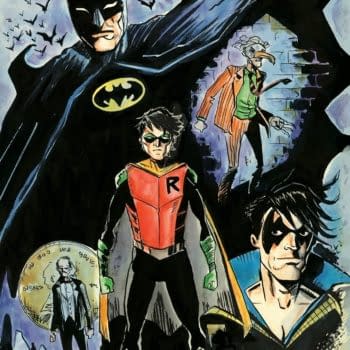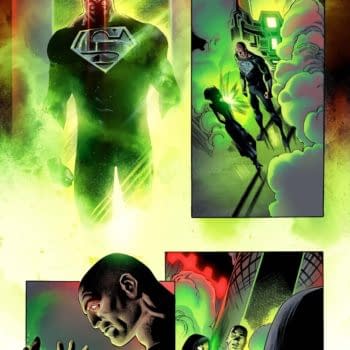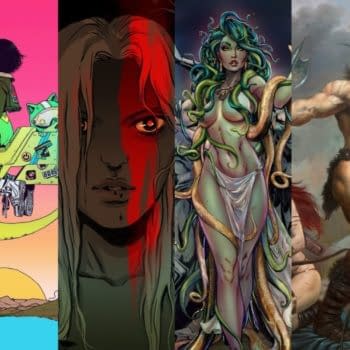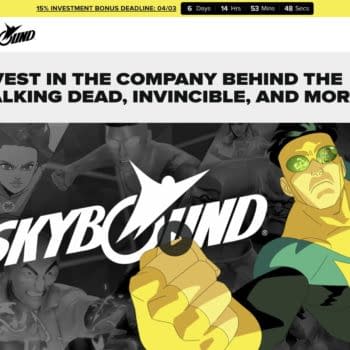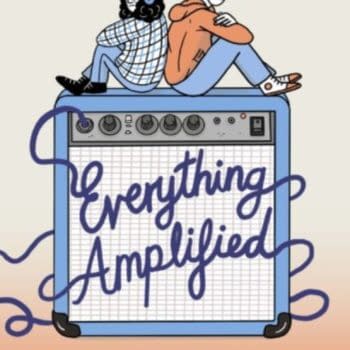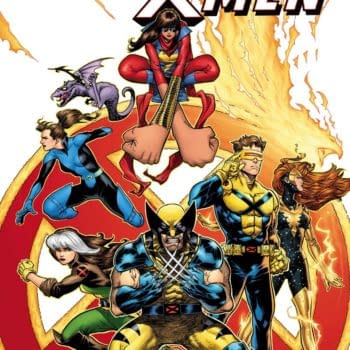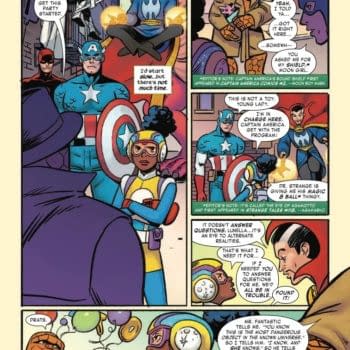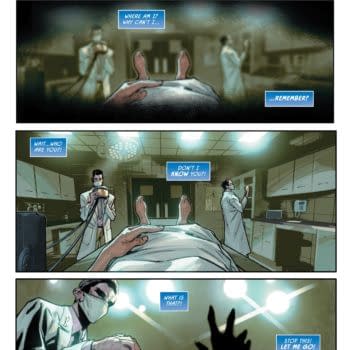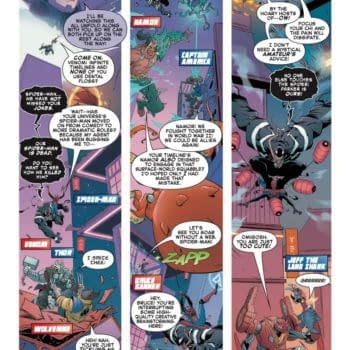Posted in: Comics | Tagged: adi tantimedh, Alan Moore, Comics, film, his heavy heart, jimmy's end, kickstarter, mitch jenkins, northampton
"The Difference Between Writing For Screen And Writing For Comics" – Alan Moore Talks To Adi Tantimedh About His Kickstarter Campaign – Look! It Moves!
Warning: contains minor spoilers.
Every time a new Alan Moore project is announced, it's a big deal. The Kickstarter campaign for His Heavy Heart, the last chapter in the Jimmy's End Cycle should be especially a big deal because it would complete the first feature length movie to be made with an original screenplay he wrote. He even appears in it as the mysterious stage mystic Mr. Metterton.
I was surprised that no one has thus far actually interviewed him in print about the films or the Kickstarter, how it was originally just one short film to be directed by acclaimed photographer Mitch Jenkins before circumstances and creative curiosity and challenge caused it to balloon into something much bigger, including plans for another feature film and TV series set in the same universe.
So here we have an interview where he talks at length about how it all came about.
The five short films of the cycle will combine together into a single story. It's a literary device, a series of stories that take place in the same place, some even the same night. There's no conventional plot or story. It's a mood piece, a series of vignettes that offer a glimpse into this world that only exists in fiction, a world that initially looks like our own, but turns out to be much more peculiar, even alien. That's what Alan Moore does, whether it's Watchmen, Marvelman, V For Vendetta, From Hell, even his DC Comics world: create an elaborate world rich in detail and character.
The two films released so far in the cycle, Act of Faith and Jimmy's End suggest a world that seems to start in our own, in an England that then takes a step into what might be a parallel world filled with mystery, mysticism and dread, where otherwise mundane lines of dialogue, pop ballads and regional British stage acts take only another meaning. It's specific, yet unfathomable. The closest comparison I can think of is the work of David Lynch their air of pop surrealism and menace. I brought that up when we were discussing H.P. Lovecraft before we started talking about the Jimmy's End Cycle.
"That fusion of the cosmic and the regional is probably not a million iles away from what we're trying to do with JIMMY'S END." Said Moore.
What's most striking about the two films ACT OF FAITH and JIMMY'S END is they're very much about local detail, and even the use of music is a very specific English kind of pop ballad that informs the whole thing.
The music is one of the joys of JIMMY'S END. You've not even heard a lot of it yet. The way that JIMMY'S END started, again, is like the way that PROVIDENCE grew from a kind of petri dish into which we placed a little bit of H.P. Lovecraft. It's actually very similar to the way that JIMMY'S END has grown. Originally, I'd known Mitch since the 80s when he took the glowering, barely-human picture of me for the back of WATCHMEN. As with a lot of people who are actually physically very close to me, we don't see each other very much because everyone's busy with their own lives. So I hadn't seen Mitch for a number of years, and he finally approached me and said that he was getting a bit fed up with doing these high-end celebrity pictures or publicity shots for the latest HBO drama or whatever. It's great work and he really enjoys it, but he just wanted to do something that was more creative. So he asked me if I had any text lying around. The only thing I'd got was a piece that I'd written about Steve Moore. So I gave that to Mitch and said if there was anything in there that he could use, then use it with my blessing. He came back and said he wanted to do the entire thing as a huge photo book that would fuse the text with the images that he was thinking of.
Speaking of which, I did get the hardcover book and you're right, it is the size of a coffee table.
AM: Yes, it's a Table of Light, as Iain Sinclair referred to it, and that quote will probably go on the back of a future edition. So we spent four or five years, I think, bringing that to completion, and in the meantime, it had also spawned a boxset album with Adam & Andy, with Crook & Flail, who had done a brilliant job in bringing in all of these really, really hip musicians, people who are really respectable. So we'd done all that, and when I was doing DODGEM LOGIC, Mitch said he'd like to do some sort of contribution to DODGEM LOGIC. Melinda was doing an article about the burlesque shows that she used to see in San Francisco and also the more contemporary burlesque artists that she'd met where burlesque was becoming a different thing, where the majority of the audience was female. It's a celebration rather than a degradation of women. It's women performing to make themselves feel good as much as anything. So Mitch, when he was asking to do something for DODGEM LOGIC, the idea of Melinda's article came up and he said, "Yeah, great! I'll book somewhere like Jimmy's End Club" because that's a sort of archetypal working men's club that you don't really see anymore. So we did the photo shoot down at Jimmy's End Club. We got all the burlesque girls down there, we got a couple of characters that Mitch had just dragged in… There was somebody playing a clown, there was Melinda herself appearing as some sort of dyke manageress, I was in-shot in one of the pictures. So when we were making up names for the characters at the end, I was credited as "the Eastern European organ trader" because that was pretty much what I looked like.
So a while later, Mitch called round and said that – I think he actually won an award for that piece in DODGEM LOGIC – he was certainly nominated for a Documentary Photograph Award on the strength of those burlesque photos. He came round and said that most people knew him as a stills photographer, but back in the day, Mitch used to do music videos, pieces for Bauhaus, Red Lorry Yellow Lorry, and he wanted to do a little short film for his showreel, recreating the burlesque shoot we'd done at Jimmy's End club. He said, "We'll do the same location, we'll get the same characters down there, plus a couple of others. I'd like to get Siobhan Hewlett involved," an old friend of Mitch's. "And I'd like to get Bob Goodman", who's an old friend of both me and Mitch.
At this point, I said, perhaps quite recklessly, "Would you like me to write a10-minute script?"
So he said, "Fine." And on the basis of the characters that we got to use – a clown, Melinda, me, the burlesque girls, Faith/Siobhan, and Bob Goodman – I thought, all right, let's just do a complete 10-minute story that'll go no further, that gives all of its punch in the final minutes, that's got to pay off and is complete in itself. So I wrote that, and we got a lot of interest from people who wanted to help us make it. A lot of it wasn't on the terms we wanted to make a film on, so we passed on some of these things. Hewlett-Packard was interested in bringing in JIMMY'S END as the first film to be premiered as an app. They were talking about the possibility of doing this, they were very, very keen, and in fact, it was when they were trying to get the software people to upload their planned features for JIMMY'S END onto their tablet that they were informed their tablet didn't do as well as they thought it did, and they got out of hardware altogether, bought a software company for billions that turned out not to be actually worth that much, as I understand it, strange move, but anyway, while working with Hewlett-Packard, they were sort of saying, "Can you come up with additional bits we can build around this?" So I came up with a lot of supplementary tiny film ideas that would fit in with the main story, and I also started to expand my thinking on the project.
Initially, when someone said, "Can you expand the JIMMY'S END idea into a feature film?" I said, "No, not really, because the whole pay-off of it was written as a short story, and once you have that pay-off, you can't have anywhere else to go with it."
It does feel like an end-point.
Yeah. But once I thought about it, I suppose my vanity was stung. I thought, "Actually, I should be a good enough writer to work out a way around this without changing the original." I didn't want to do that, it would seem to be cheating. Don't know why, completely irrational, so what I decided to do was expand my thinking about that original piece and see it as a possibly-misleading episode that would make a different sort of sense in a bigger context. So these small supplementary films are what we've come to call "THE JIMMY'S END CYCLE". There's five of them in all. There's JIMMY'S END itself, then we wrote three other short films that would go around that. Then Hewlett-Packard pulled out of the deal because they'd got their own problems.
At this point, me and Mitch were a little bit despondent about whether we were ever going to get our film made. We were saying, "What should we do, then?" And Mitch said, "Let's do one of the other little short films just to show what we can do and hope that'll generate some interest." I said, "Yeah, that's a great idea." Then thought about it for about five seconds and said, "No, that's a rubbish idea, because those are the films that let you know too much about the world of JIMMY'S END." Then I said, "What if I try to write something that is outside that and doesn't give anything away but is somehow connected and is really central to the story?" And he said, "Yeah, if you could make it cheap with just a couple of characters and a couple of sets that would be a real blessing." I got back to him the next day. I'd written what was originally mean to be a five-minute film with one actress and one set. That was ACT OF FAITH, which could be seen as a complete story in itself but when seen in context with JIMMY'S END, you can start to see the connections.
So we made ACT OF FAITH, which I think Mitch did in about a day, day-and-a-half at a location in London. Siobhan was brilliant. I didn't actually attend that shoot because I didn't want to see… I'd met Siobhan, she's a lovely girl, really nice, and I didn't want to see her choking to death in a closet because of something that I'd written. I was starting to see the difference between writing for screen and writing for comics. Paper characters do not exist, and though I treat all of them with respect, even the fictional ones, I sometimes do horrible things to them, safe in the knowledge they're only lines on paper. But I didn't want to be in the Alfred Hitchcock position, if you know what I mean?
Absolutely.
AM: I didn't want to be standing there gloating from the sidelines while an attractive blonde was placed in a precarious position, no. But I went down to Jimmy's End –
Well, you were in the cast!
I realise it's only a movie now. People aren't really getting strangled.
Yeah, it was quite an education. As a writer, I've learned an awful lot from doing this film. The way that films work is completely different from the way that books work, and that's different from the way that comics work. Although they all involve writing, they all involve completely different processes. With a book, there is no more to the story than what I put down on the page. With a comic book – I'm looking here at a single page of a notebook that has got fifteen pages of the second book in the HEART OF ICE sequence with all the dialogue crammed onto one page, and these are tiny little scribble drawings, but I can pretty imagine what it's going to look like when Kevin's finished with it. Right now, I know pretty much what this book's going to look like. With a film, that's different. I write my screenplay and that's like a floor plan. The film will be built upon by the actors, by the director, by the set designer, by all of these people who will all be bringing themselves to it, bringing what they've got to offer, which is the way that Mitch and I prefer to work. You want people to bring what they've got. If it fits, then we want to use it. So with the finished thing, it's important to come up with a structure that can be filled in interestingly with the music and the performance and the lighting and everything. So I wrote JIMMY'S END and the other films I wrote with it, we've got ACT OF FAITH, and that did do an awful lot for people to come forward and provide the necessary money for JIMMY'S END.
While we were doing JIMMY'S END, we also did two of the other short films. There's one called UPON REFLECTION. What this does is to actually fill in the enigmatic gap between the end of ACT OF FAITH and the beginning of JIMMY'S END, so it's a supplementary story. It's about ten minutes long. Another one that we've done is called A PROFESSIONAL RELATIONSHIP. This is showing you the conversation happening in the little purple dressing room between Mr. Metterton and Mr. Matchbright. We see a glimpse in JIMMY'S END, the two of them in the dressing room when Mr. Matchbright tries to wash his hands, then we cut away. But in A PROFESSIONAL RELATIONSHIP, which is basically a ten-minute conversation you can only do in a short film, you can't have a ten-minute conversation in a movie. It's unheard of. So we'd got this ten-minute conversation between those two which does something to cast a light upon their professional relationship. So with those two and ACT OF FAITH and JIMMY'S END, that's four.
The final film in the JIMMY'S END CYCLE is called HIS HEAVY HEART. This is probably about twenty minutes. It's more substantial. It shows you what happens to James after the lights rise to a dazzling pitch of intensity at the end of JIMMY'S END. Because what happens is the lights come down again.
It's probably the most horrifying and the funniest of all five of the films. It's only got two or three characters in it. It's got James, played by Darrell D'Silva and it's got the clown played by Andy Buckley – who is entirely too tall. I really don't like people who are taller than me. I haven't had time to get used to it. I've not had a lot of time of looking up to these people. Andy's six-foot-five, sweet bloke, but entirely too tall. So he's in it, and the delectable Ms. Khandie Khisses, who's apparently lose a little bit of weight, which is great for her, but we're thinking about sending her three boxes of Krispy Kremes with the word "CONTINUITY!" written on top and underlined in magic marker… no, I'm sure it'll be all right.
We're doing an appeal on Kickstarter sometime in the next week or two, I believe, for some money to fund this last film which is all we need to bring out the DVD which would have tons of additional material on it as well as these five films which would be added together to be feature-length. At that point, all of the JIMMY'S END CYCLE would be finished, and I have written a very, very detailed proposal or treatment for a feature film that would be coming out of it. It wouldn't be set in the strange, dream-like working men's club that JIMMY'S END is set in, or at least not much of it would be set in. This would be set in Northampton, or at least a version of Northampton. It would be opening on the day after all of the events of the five films in the JIMMY'S END CYCLE. It's going to take place on a specific November night. We know which night it is: a specific November night in 2012, so that's a Friday night, and the feature film would start on a Saturday morning after what's happened to Faith and James and everybody else. It would be completely different. We've tried to make all of the five short films different. I mean, ACT OF FAITH isn't like JIMMY'S END, they're very different films. A PROFESSIONAL RELATIONSHIP is all from a fixed point of view, it's all as seen in a security mirror above, which again changes the whole feel as it's only one take. It's more like theatre than film. And it also puts the viewer in a very uncomfortable position because they can't look away, they can't change their viewpoint, they're kind of trapped watching something that isn't very pleasant. Like I said, A PROFESSIONAL RELATIONSHIP is a single conversation that goes on in a cramped dressing room between two very strange men. HIS HEAVY HEART is a different kettle of fish altogether, a very, very black comedy with lots of Egyptian touches. If we get round to doing the feature film, that would be done completely differently, that would have to be done like a feature film. You couldn't have this slow pacing that we were able to do in a short film of indeterminate length. We wouldn't be able to have ten-minute conversations. We want to do all of these things so that they all complement each other and build into a bigger and richer story. If we do get to make a feature film, we've got an idea for a TV series that would run for two or three seasons after that.
Whether any of this will happen, I don't know. As well as any of the dazzling, strange spin-off concepts to the world that we're creating in JIMMY'S END and hopefully this feature that we've got out of it, which is called THE SHOW. It has the same characters as JIMMY'S END, but the emphasis is different. The main character, it would focus more upon Faith and some other characters that we're bringing in as well. The treatment we've got written is pretty marvelous. I was pretty pleased with it. It's the sort of film that I'd like to go and see.
In the meantime, we're writing all of these songs with Adam & Andy and the songs themselves, if the films don't get made, we've done some brilliant songs there, like "Queen of Midnight" with Tunde Adebimpe from TV On The Radio. There's the one you also hear which is "We're In The Past Again", which is kind of Carpenters-esque, and we were looking to get Nona from Dark Dark Dark, who as it turns out, is a huge Karen Carpenter fan. So she was doing the vocal on that and did an absolutely spellbinding job on it. We also got Alan Sparhawk from Low. You'll hear these in the other pieces. He does a couple of great numbers, "Television Heart", "See Me on Main Street", which is probably my favourite thus far. There's even a little Jimmy Osmond/David Cassidy-type number, "Don't Let Them Know That We're In Love", that Is playing during the Mr. Metterton-Mr. Matchbright conversation and is quite funny in its juxtaposition. Yeah, all of this stuff, we had a lot of fun. We're just playing, but we're playing with all the skills that we have. So we want this to be the kind of films that we'd be proud of and that fit with our criteria of how films should be made, you know?
And it sounds like you prefer to own the film rather than it ending up in the hands of someone else.
We own everything. Orphans of the Storm, which is our production company that we've set up, that owns everything. If people want to share in that with us and get a fair amount for what they contribute, that is fine. But if people want Intellectual Property rights, if people want editorial control, no, that's not going to happen.
We think that we have got a pretty good business model here. If we can make a film like JIMMY'S END for a hundred grand along with these other short films that we've made as well… ACT OF FAITH was eleven grand.
And it doesn't look like an indie film. It doesn't look like a first film. It looks like a pretty sophisticated big studio production job. That's what we can do with a little bit of money. We have deliberately asked to make a feature film and we can do an absolutely stunning job for about five million. Certainly no more than that. I mean, the idea of spending hundreds of millions… no film is worth that. If you can't do it for less than that…
These films are going to be done the way that Mitch and I want to do them or they won't be done. We've got a very hardline approach which might ultimately mean that they don't get done, you know, but me and Mitch are happy with what we've done so far. Everybody's done a brilliant job and we hope that when people have listened to the music, seen the other films, that they'll realise that we're offering a very unusual flavor here and a bit of an unusual art event in that it's hopefully very accessible. I mean, I don't think that JIMMY'S END comes across as an arthouse film. It's kind of like weird mainstream cinema.
We're ready to go as soon as we've got the money. And we don't need a huge amount of money. Once we've got that done, me and Mitch are appearing with Adam Curtis the filmmaker – he's going to be interviewing us at the Latitudes Festival on the 21st of July. If we've got any of HIS HEAVY HEART to show, we might that then, a quick edit, because our editor Colin, who was the editor on MONSTERS, and who is a genius, he doesn't take long to turn around a bit of editing, so he'll perhaps have a rough cut. It's possible. It's not likely but it's possible. At least by the time we get to July at the Latitudes Festival, we should know a lot more about what's happening with all this stuff. So yeah, it trundles ahead and very interesting it is too.
You can support His Heavy Heart and The Jimmy's End Cycle at its Kickstarter page.
No god but the God of Cinemaat lookitmoves@gmail.com
Follow the official LOOK! IT MOVES! twitter feed at http://twitter.com/lookitmoves for thoughts and snark on media and pop culture, stuff for future columns and stuff I may never spend a whole column writing about.
Look! It Moves! © Adisakdi Tantimedh











